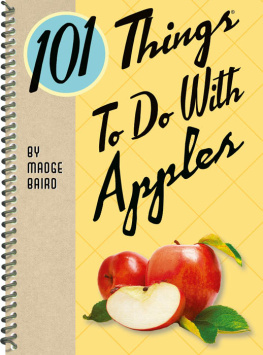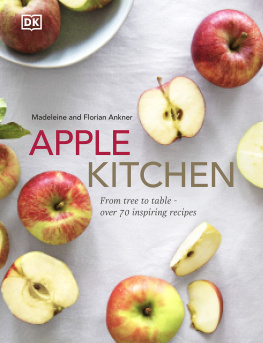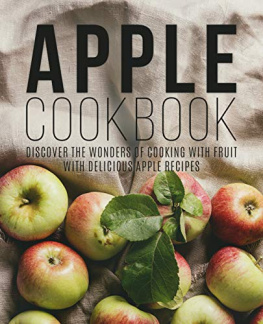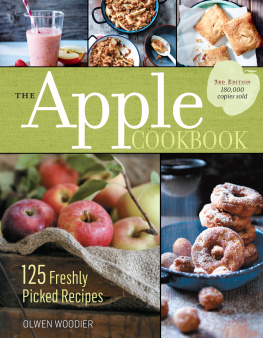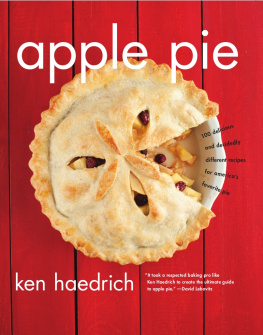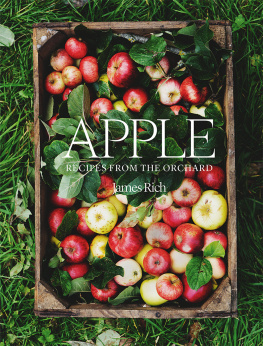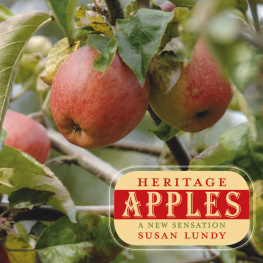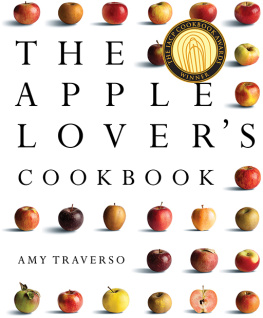Helpful Hints
1. About 7,500 varieties of apples are grown throughout the world. More than 2,500 varieties are grown in the United States and Canada.
2. Some varieties are better for baking than others. Pie apples should hold up and not become mushy when baked: neither should they remain crunchy. Granny Smith, Jonathan, Jonagold, Pink Lady, Golden Delicious, Rome, McIntosh, and Braeburn are a few good varieties for pies. The same varieties, plus many others, can be used for any of the recipes in this book where the apple is cooked. The fact is, all varieties will soften if cooked for a long enough time, but sometimes that would be longer than is good for the rest of the dish, such as the piecrust. The smaller the pieces of apple, the faster they cook.
3. For fresh eating, salads, sandwiches, and recipes where the apple will be distinguishable and a bit of crunch is desired, sweet, crisp apples are preferred though not mandatory. The sweetness depends on factors during the growing period and at what point they were harvested. Apples freshly picked from the tree are crisp, but their texture changes the longer they are stored. Some varieties stay crisp longer than others.
The key is to taste a sliver of the apple and see if it meets your expectations for the particular dish. If its a bit too tart, you might consider adding a small amount of sweetener; if already sweet, you may want to proceed without adding sweeteners or reduce the amount being addedunless making baked goods such as cakes or cookies, where the sugar becomes part of the total liquid and volume of the baked product.
4. Any apple can be used for cooking if the recipe calls for grating, chopping, mashing, or pureeing the finished dish (as in cakes, cookies, breads, soups, and sauces).
5. Two pounds of apples make a 9-inch pie. There are two or three large apples in a pound.
6. To peel or not to peel? Its a matter of taste. Two-thirds of an apples fiber is in the skin. The skin is high in antioxidants, and most of an apples vitamin C content is just under the skin.
7. Consider leaving the skin on when a recipe calls for grated or chopped apples.
8. The USDA recommends washing apples before eating them.
9. Many of the salad recipes in this book can be easily used for sandwiches, and vice versa.
10. In recipes where the apple is cooked with other ingredients, the apple is somewhat like a potato in that it absorbs the other flavors. In that way, apples are good recipe extenders.
11. Apples ripen or soften ten times faster at room temperature than when kept refrigerated.
12. Wrinkled apples, or those beyond their prime (but not spoiled), are ideal for making cobblers, cakes, soups, and applesauce. Waste not, want not!
13. A little lemon juice can wake up the flavor of bland apples for applesauce or in other recipes.
Salads and Sandwiches
Waldorf Salad
| 2 cups diced apple* |
| 1 cup chopped celery |
| 1/3 cup chopped walnuts or pecans |
| 3/4 cup mayonnaise |
| 2 tablespoons lemon juice |
| 2 teaspoons sugar |
| 4 lettuce leaves, optional |
Place apple, celery, and nuts in a medium bowl. In a separate bowl, combine mayonnaise, lemon juice, and sugar. Fold dressing into the apple mixture. Serve on lettuce leaves, if desired. Makes 4 servings.
*Gala apples are a nice choice for this salad in winter months, as they stay crisp and are slower to oxidize (turn brown) than some other varieties.
Pistachio, Chicken, and Apple Salad
| 2 cups diced crisp apple |
| 1 cup diced celery |
| 2 tablespoons diced red bell pepper |
| 1/2 cup pistachio nuts |
| 1-1/4 cups diced grilled chicken |
| salt, to taste |
| 2 tablespoons French or Catalina dressing |
| 1/2 cup mayonnaise |
| 6 lettuce leaves or sandwich buns |
Place apple, celery, bell pepper, nuts, and chicken in a medium bowl. Sprinkle with salt. In a separate bowl, combine dressing and mayonnaise. Fold into the apple-chicken mixture until well coated. Serve on lettuce leaves or buns. Makes 6 servings.
Warm Grilled Chicken, Apple, and Leek Salad
| 2 medium apples, cored and cut into thin wedges |
| 2 tablespoons melted butter or margarine |
| 1 cup thinly sliced leek, white and green |
| 2 tablespoons olive oil, divided |
| 4 medium handfuls spinach leaves |
| 1 large chicken breast, grilled and thinly sliced |
Honey Vinaigrette:
| 3 tablespoons fresh lemon juice |
| 2 tablespoons honey |
| 1/3 cup extra virgin olive oil |
| 1 tablespoon chopped fresh herbs (parsley, tarragon, or thyme) |
| salt, to taste |
| pepper, to taste |
Dip apple slices in butter and place in a hot frying pan or outdoor grill basket; cook for about 2 1/2 minutes per side, until apple begins to soften. Set aside. Grill sliced leeks in same pan until wilted, about 10 minutes, using 1 tablespoon oil and any remaining butter; set aside. Saute spinach in 1 tablespoon oil over high heat until wilted, tossing constantly. Reheat chicken in the grill pan.
Assemble salads on four serving plates in the following order: spinach, leeks, apple, and chicken.
For the vinaigrette, whisk lemon juice, honey, and oil together in a small bowl until emulsified and thickened. Add herbs, salt, and pepper. Divide over salads. Makes 4 servings.
Apple Slaw
| 2 cups shredded cabbage |
| 2 cups shredded crisp, red-skinned apple |
| 1/3 cup light mayonnaise |
| 1 tablespoon apple cider vinegar |
| 1/2 teaspoon celery seed |
| 1/2 teaspoon salt |
Toss cabbage and apple in a medium bowl. In a separate bowl, whisk together the mayonnaise, vinegar, celery seed, and salt. Pour dressing over slaw and toss to coat. Serve chilled. Makes 4 to 6 servings.
Tuna Apple Salad
| red leaf lettuce, torn to make about 3 cups |
| 2 large apples, cored and sliced |
| 3 ribs celery, sliced |
| 1 can (6 ounces) tuna, drained |
Honey Mustard Dressing:
| 4 tablespoons extra virgin olive oil |
| 1 tablespoon plus 1 teaspoon apple cider vinegar |
| 1/4 teaspoon mustard powder |
| 1/8 teaspoon salt |
| Pinch thyme |
In a medium bowl, layer lettuce, apple, and celery. Place tuna on top and break up with a fork.
Whisk dressing ingredients together in a small bowl until well blended. Pour over salad and toss. Makes 2 servings.

